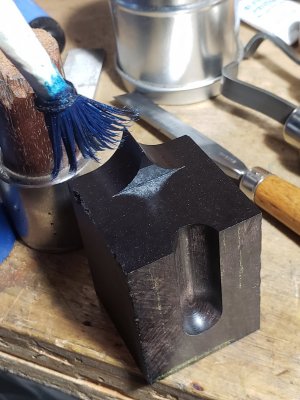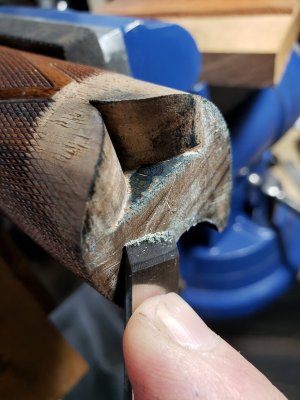Not scraping metal, but wood. I need to epoxy two dissimilar types of wood together. The one part is flat, the other has a feature that has to be inlet into the first part. Just like scraping two metal parts for contact, but instead of a surface plate and roller, I sparingly blot a blue dye onto the piece with the feature, put the two pieces together, and the blue dye gets scraped, or chiseled or filed away, from where it has marked the flat piece. Repeat a gazillion times until you have a perfect fit. The trick is to use very little dye, and to know how much you can rough out before going gentle.
-
Spring 2024 meetup in Calgary - date Saturday, April 20/2024. discussion Please RSVP Here to confirm and get your invitation and the location details. RSVP NOW so organizers can plan to get sufficient food etc. One week to go! More info and agenda
-
We are having email/registration problems again. Diagnosis is underway. New users sorry if you are having trouble getting registered. We are exploring different options to get registered. Contact the forum via another member or on facebook if you're stuck. Update -> we think it is fixed. Let us know if not.
You are using an out of date browser. It may not display this or other websites correctly.
You should upgrade or use an alternative browser.
You should upgrade or use an alternative browser.
Scraping
- Thread starter thestelster
- Start date
Thanks Brent, I might take you up on the offer. Most of the wood I use for stocks is European Walnut. Fore-end tips or grip caps are either ebony or cocobolo.You may need to come up for a sleep over wood session. LOL - let me know if you need some different woods
Thanks Brent, I might take you up on the offer. Most of the wood I use for stocks is European Walnut. Fore-end tips or grip caps are either ebony or cocobolo.
Sometimes a piece of American Black or Claro Burl Walnut makes an awesome cap and forend tip. The burl is denser and darker than the European Walnut so the contrast is similar, but i think that the grain of the burl is phenomenal.
Chicken lights
Forum Pony Express Driver
We used to cut burls off, to save them for woodworkers. That’s something I haven’t thought of for a few yearsHere is a photo.
View attachment 24208
The other nice thing about burl is that the grain is not usually directional so it looks great from all angles.
We used to cut burls off, to save them for woodworkers. That’s something I haven’t thought of for a few years
I spotted a huge burl on a sugar maple tree in my brother in laws bush. The tree had been earmarkered for removal by the local conservation authority. He had them give him the burl and then he had it sawn into slabs. I have one piece in the shop. It's hard as nails.
I know where there is a smaller one on a wild black cherry in the forest beside my house. I don't want to harvest it till I have to.
Chicken lights
Forum Pony Express Driver
Wood/lumber is an interesting topic. I’m far from the most knowledgeable but the veneer trees always were a source of contention over qualityI spotted a huge burl on a sugar maple tree in my brother in laws bush. The tree had been earmarkered for removal by the local conservation authority. He had them give him the burl and then he had it sawn into slabs. I have one piece in the shop. It's hard as nails.
I know where there is a smaller one on a wild black cherry in the forest beside my house. I don't want to harvest it till I have to.
Every species of tree has a market, and with that market comes needed lengths. Cedar needs to be X size and length for fence posts/poles. White pine needs to be long and no taper for log homes. Hardwoods need to be straight and knot free for quality boards. Pallet lumber needs to be 8’s 12’s 16’s (divisible by 4). On and on and I never did any of the northern or western harvesting, pulp lumber is fairly straightforward but again it can’t be over a certain diameter depending on the mill setup
Blah. But back to burls, they are cool “defects” in a tree that make amazing grain for projects
Surgar maple and black cherry growing wild in your "backyard"....to a Prarie kid that's almost as attractive as having brass and stainless steel trees growing in your backyard.I spotted a huge burl on a sugar maple tree in my brother in laws bush. The tree had been earmarkered for removal by the local conservation authority. He had them give him the burl and then he had it sawn into slabs. I have one piece in the shop. It's hard as nails.
I know where there is a smaller one on a wild black cherry in the forest beside my house. I don't want to harvest it till I have to.
@thestelster I'm a long time epoxy sniffer, mainly for RC work but other applications too. Just curious, what kind do you use for work like this?
Surgar maple and black cherry growing wild in your "backyard"....to a Prarie kid that's almost as attractive as having brass and stainless steel trees growing in your backyard.
I'm busy as an ant on a hot chocolate bar planting right now, but if I can remember, I will take a photo of a Black Walnut I have that is amazing. It is straight as an arrow for 50 ft with no branches. I have bigger ones, but none so straight for so long.
Hi Peter, I usually use West System G/Flex 650. I also use J.B. Weld. The longer the cure time=stronger the bond. In my case here, I will also include mechanical strengthening of the joint, such as dowel pin, stainless threaded bolt, small holes in both parts so that the epoxy flows into.@thestelster I'm a long time epoxy sniffer, mainly for RC work but other applications too. Just curious, what kind do you use for work like this?
Just like scraping two metal parts for contact, but instead of a surface plate and roller, I sparingly blot a blue dye onto the piece with the feature, put the two pieces together, and the blue dye gets scraped, or chiseled or filed away, from where it has marked the flat piece.
I used to use dental marking paper for this back when I was doing such things. Very fast to use. Put the transfer film in, push the parts together, pull apart, and sand or Dremel. (ya, a gazzilion times) There used to also be a special bright yellow wood marking fluid you could use that would not stain the wood. I prolly still have some, but it's been years since I did anything like that so I'm not really sure where it is.
Surgar maple and black cherry growing wild in your "backyard"....to a Prarie kid that's almost as attractive as having brass and stainless steel trees growing in your backyard.
I posted a few pictures on another thread.
https://canadianhobbymetalworkers.com/threads/crossing-canada-need-anything-moved.5306/post-77780
historicalarms
Ultra Member
Stock makers & inlayers have my undying admiration & respect. Metal work is a snap compared to excellent wood work.





